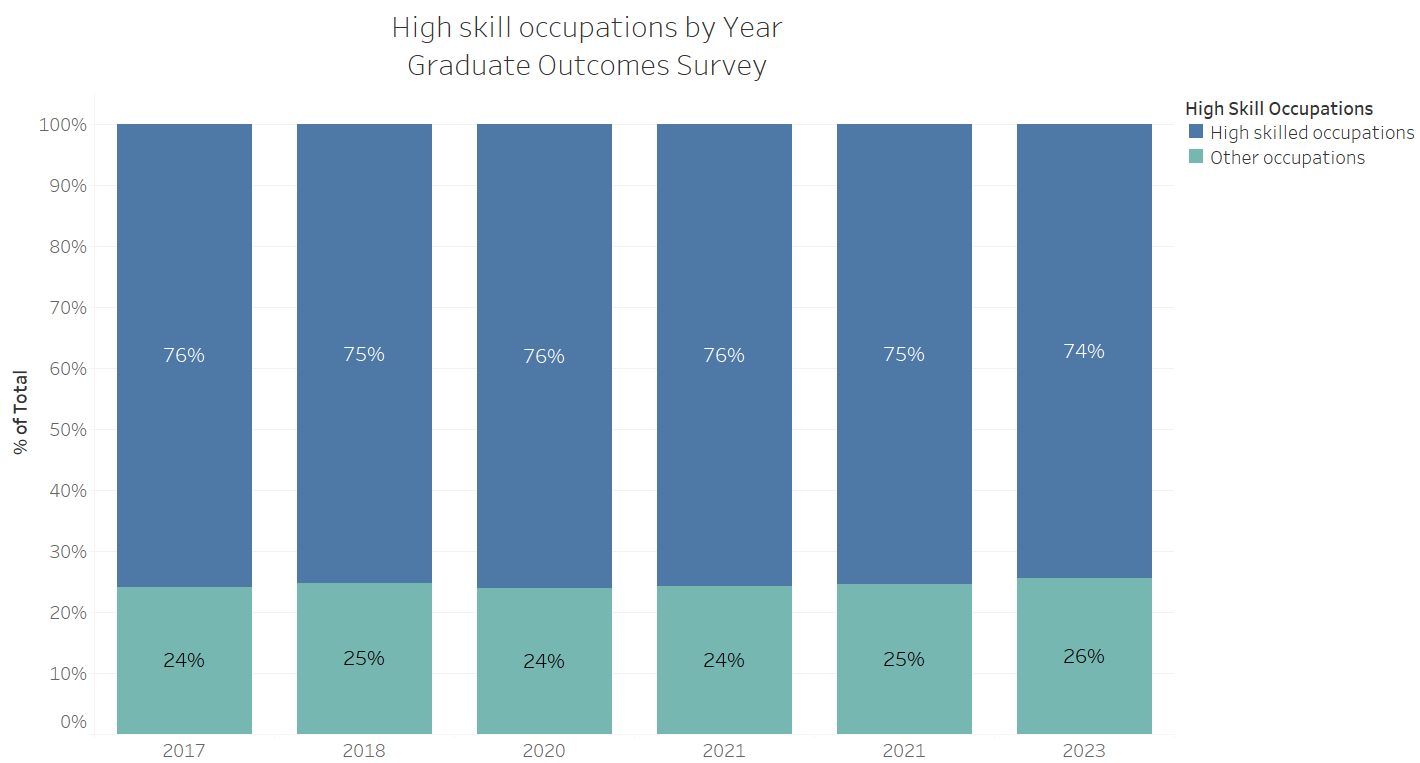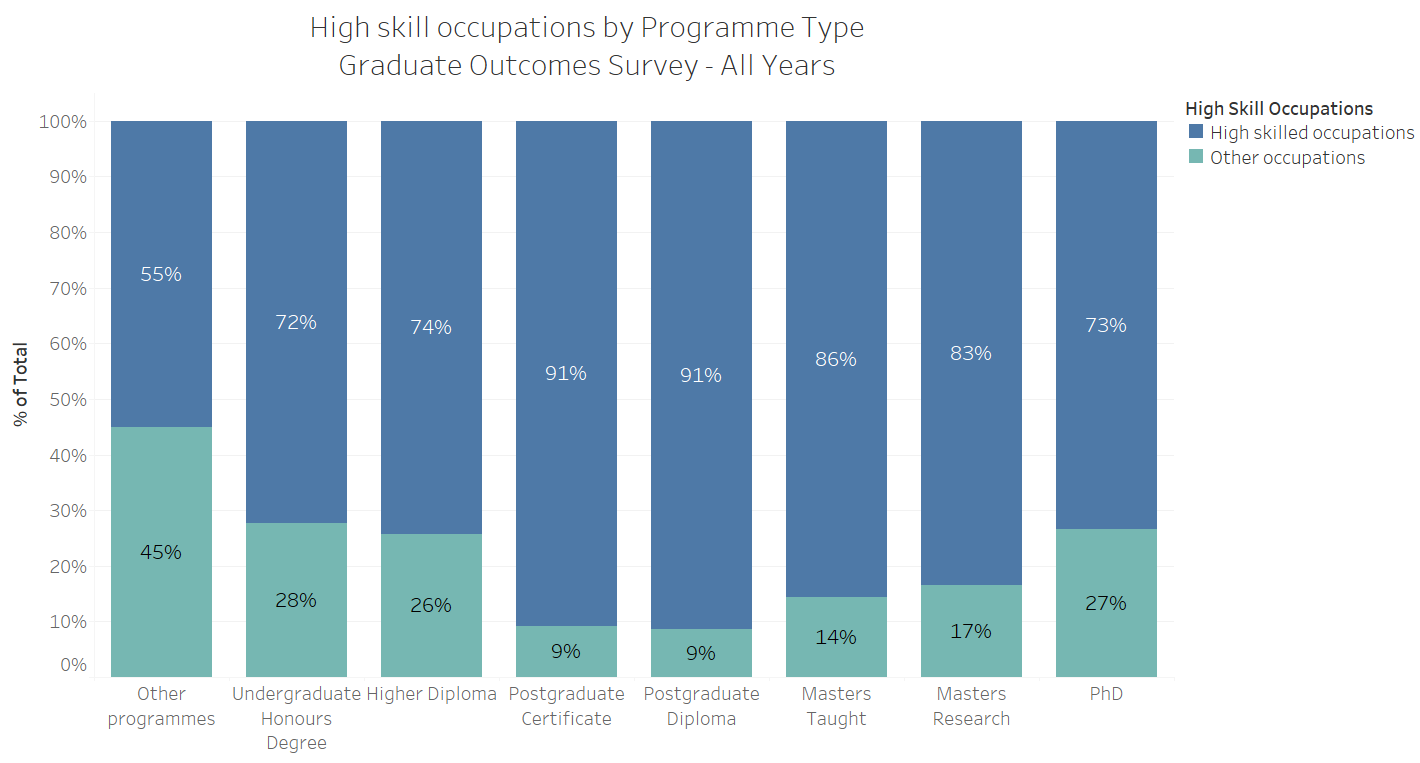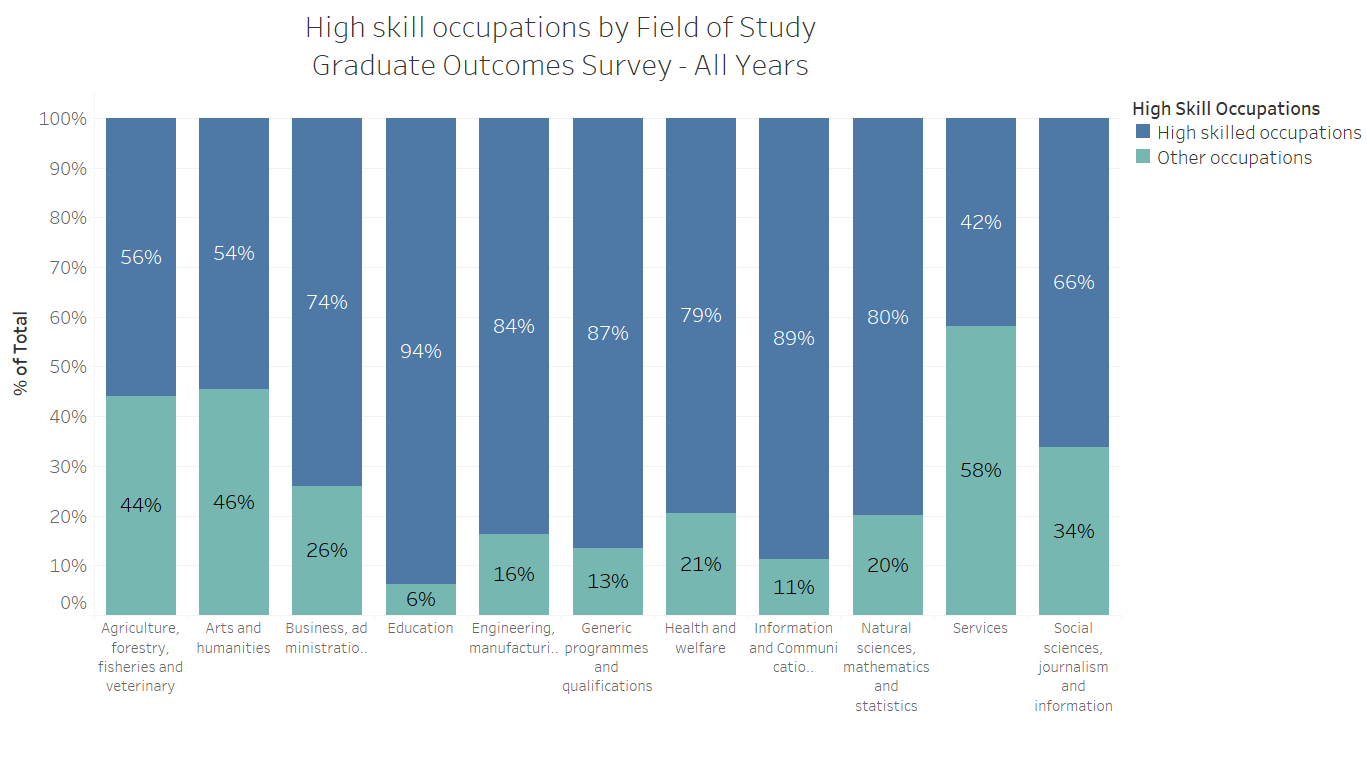Graduate Outcomes Survey: Sectors and Occupations
Focus on Occupations
As noted previously, the following is a list of occupations collected in the Graduate Outcomes Survey:
- Managers, directors and senior officials
- Professional occupations
- Associate professional and technical occupations
- Administrative and secretarial occupations
- Skilled trades occupations
- Caring, leisure and other service occupations
- Sales and customer service occupations
- Process, plant and machine operatives
- Elementary occupations
- Postdoctoral researchers
- I don’t know/unknown
The chart below displays graduate occupations overall years of the Graduate Outcomes Survey, and the reader can be select programme type, field of study, and year.
- Over half (53%) of all graduates were working in Professional Occupations. The next most common occupation type was Associate Professional and Technical Occupations at 14%.
- The next most common occupation was Administrative and Secretarial Occupations (7%), followed by Sales and Customer Service Occupations (6%) and Managers, Directors and Senior Officials (5%).
- This means that 72% of all graduates entered the three high skilled occupations (Professional Occupations, Associate Professional and Technical Occupations and Managers, Directors and Senior Officials) within nine months of graduation (the census date of the Graduate Outcomes Survey). A further 1% were employed as Postdoctoral Researchers. This figure compares with 45% of the national total as provided in the SOLAS National Skills Bulletin 2024.
- The occupation types with the lowest proportion of graduates employed included and Process, Plant and Machine Operatives (1%) and Postdoctoral Researchers (1%).
The following chart gives the percentage of graduates who moved directly into high skilled occupations by year and shows that there has been little change in the occupational skill level of graduates between 2017 and 2023.

Programme Type
We consider different programme types in more detail here.
Honours Degree Graduates
- For honours degree graduates, Professional Occupations were the most common occupation type with 51% of graduates.
- The second most common occupation type (15%) was Associate Professional and Technical Occupations.
- This was followed by Sales and Customer Service Occupations (9%), Administrative and Secretarial Occupations (7%), and Caring, Leisure and Other Service Occupations (5%).
- A total of 3% of honours degree graduates moved directly into employment as Managers, Directors and Senior Officials.
- This means that 69% of honours degree graduates moved directly into the three high skilled occupations (Professional Occupations, Associate Professional and Technical Occupations and Managers, Directors and Senior Officials) within nine months of graduation.
Postgraduate Degree Graduates
- Professional Occupations were the most common occupation type across Postgraduate Degree Graduates with 61% of graduates.
- The second most common occupation type (12%) was Associate Professional and Technical Occupations.
- This was followed by Managers, Directors and Senior Officials (9%), Administrative and Secretarial Occupations (5%), and Sales and Customer Service Occupations (5%).
- This means that 82% of postgraduate degree graduates moved directly into the three high skilled occupations (Professional Occupations, Associate Professional and Technical Occupations and Managers, Directors and Senior Officials) within nine months of graduation. A further 2% were working as Postdoctoral Researchers.
The following chart gives the percentage of graduates who moved directly into high skilled occupations by programme type.

Field of Study
We consider different fields of study in more detail here.
For Arts and Humanities graduates, the distribution of occupations is wider than for other fields of study. A total of 33% entered Professional Occupations. This is followed by 18% in Sales and Customer Service Occupations, 14% in Associate Professional and Technical Occupations and 10% in Administrative and Secretarial Occupations.
This wider distribution of occupations is also seen with graduates of Services programmes, with 22% in Administrative and Secretarial Occupations, 21% in Professional Occupations, 11% in Skills Trades Occupations, 9% in Associate Professional and Technical Occupations, 9% as Managers, Directors and Senior Officials and 9% as Sales and Customer Service Occupations.
For Business, Administration and Law graduates, 43% were employed in the Professional Occupations. This is followed by 16% employed in Associate Professional and Technical Occupations and 12% as Managers, Directors and Senior Officials.
88% of Education graduates were employed in Professional Occupations.
For graduates of Engineering, Manufacturing and Construction, 61% were employed in Professional Occupations, 16% in Associate Professional and Technical Occupations and 7% in Skills Trades Occupations
For Health and Welfare graduates, 68% were employed in Professional Occupations, followed by 14% in Caring, Leisure and Other Service Occupations.
A total of 52% of ICT graduates were employed in Professional Occupations, followed by 28% in Associate Professional and Technical Occupations
For Natural Sciences, Mathematics and Statistics graduates, 52% were employed in Professional Occupations, followed by 22% in Associate Professional and Technical Occupations.
For Social Sciences, Journalism and Information, nearly half (48%) were employed in Professional Occupations, followed by 13% in Administrative and Secretarial Occupations.
The following chart shows the percentage of graduates entering the three high skilled occupations (Professional Occupations, Associate Professional and Technical Occupations and Managers, Directors and Senior Officials) within nine months of graduation by field of study.

The next section of this report gives a further breakdown of occupations into economic sectors.